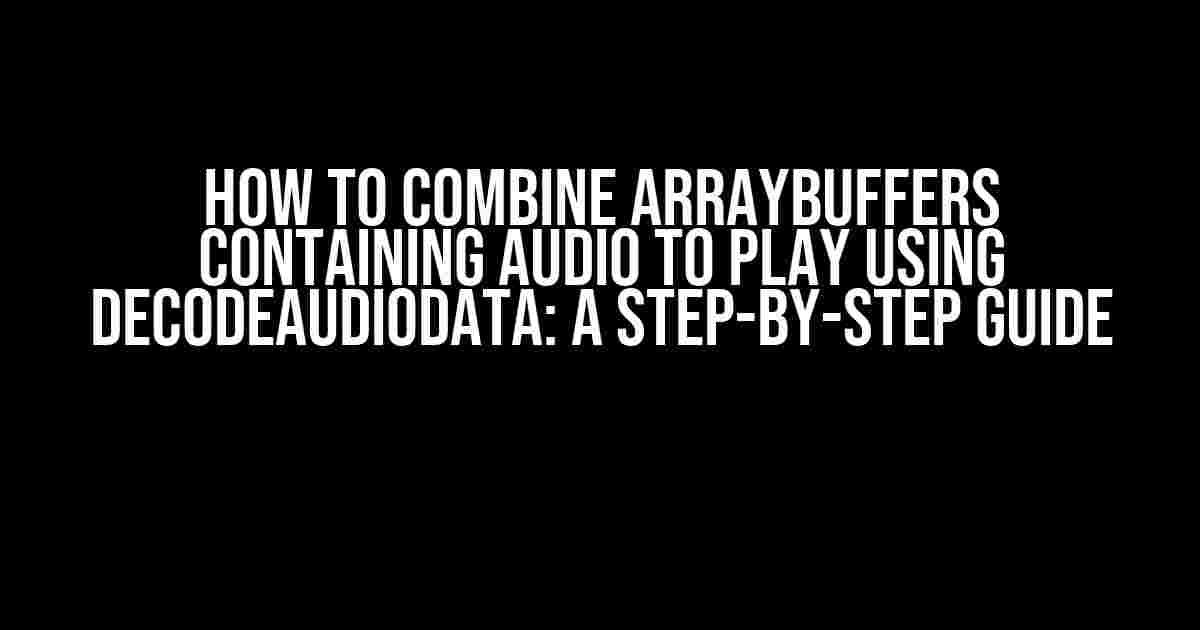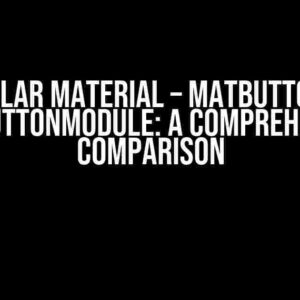Are you tired of dealing with multiple audio files and wanting to merge them into a single, cohesive audio experience? Look no further! In this comprehensive guide, we’ll walk you through the process of combining ArrayBuffers containing audio data using DecodeAudioData. By the end of this article, you’ll be able to seamlessly merge your audio files and play them back like a pro.
- What is DecodeAudioData and Why Do We Need It?
- Preparation is Key: Gathering Our Audio Buffers
- The Magic Happens: Combining Our ArrayBuffers
- DecodeAudioData to the Rescue: Decoding Our Combined ArrayBuffer
- Tips and Tricks: Handling Audio Segments with Different Sample Rates
- Conclusion: Combining ArrayBuffers like a Pro
What is DecodeAudioData and Why Do We Need It?
DecodeAudioData is a powerful Web Audio API method that takes an ArrayBuffer containing compressed audio data and decodes it into an AudioBuffer. This AudioBuffer can then be played back using an AudioContext, allowing for real-time audio processing and manipulation.
But what happens when we have multiple ArrayBuffers containing different audio segments? That’s where combining ArrayBuffers comes in – and that’s exactly what we’ll be covering in this article.
Preparation is Key: Gathering Our Audio Buffers
Before we dive into combining our ArrayBuffers, let’s assume we have two separate audio files: `audioFile1.wav` and `audioFile2.wav`. We’ll use the Fetch API to fetch these files and convert them into ArrayBuffers.
fetch('audioFile1.wav')
.then(response => response.arrayBuffer())
.then(arrayBuffer => {
// arrayBuffer1 contains the audio data from audioFile1.wav
});
fetch('audioFile2.wav')
.then(response => response.arrayBuffer())
.then(arrayBuffer => {
// arrayBuffer2 contains the audio data from audioFile2.wav
});
In a real-world scenario, you might have an array of ArrayBuffers, each containing a segment of audio data. For the sake of simplicity, we’ll focus on combining two ArrayBuffers in this example.
The Magic Happens: Combining Our ArrayBuffers
To combine our ArrayBuffers, we’ll create a new, larger ArrayBuffer that can hold both audio segments. We’ll then use the `TypedArray.prototype.set()` method to copy the data from each ArrayBuffer into the new one.
const combinedArrayBuffer = new Uint8Array(arrayBuffer1.byteLength + arrayBuffer2.byteLength);
combinedArrayBuffer.set(new Uint8Array(arrayBuffer1));
combinedArrayBuffer.set(new Uint8Array(arrayBuffer2), arrayBuffer1.byteLength);
In this example, we create a new `Uint8Array` with a length that’s the sum of both ArrayBuffers’ lengths. We then use `set()` to copy the data from `arrayBuffer1` into the beginning of the new ArrayBuffer, and `arrayBuffer2` into the remaining space.
DecodeAudioData to the Rescue: Decoding Our Combined ArrayBuffer
Now that we have our combined ArrayBuffer, it’s time to decode it using DecodeAudioData. This method takes an ArrayBuffer as an input and returns a promise that resolves with an AudioBuffer.
const audioContext = new AudioContext();
const source = audioContext.createBufferSource();
audioContext.decodeAudioData(combinedArrayBuffer).then(audioBuffer => {
source.buffer = audioBuffer;
source.connect(audioContext.destination);
source.start();
});
In this example, we create a new AudioContext and a BufferSource node. We then pass our combined ArrayBuffer to `decodeAudioData()`, which returns a promise that resolves with an AudioBuffer. We assign this AudioBuffer to our BufferSource node and connect it to the audio context’s destination. Finally, we start the playback using `start()`.
Tips and Tricks: Handling Audio Segments with Different Sample Rates
What happens when our audio segments have different sample rates? This can lead to issues during playback, as the audio context expects all audio data to have the same sample rate.
To handle this scenario, we can use the `resampleAudioBuffer()` function, which takes an AudioBuffer as an input and returns a new AudioBuffer with the desired sample rate.
function resampleAudioBuffer(audioBuffer, sampleRate) {
const offlineContext = new OfflineAudioContext(1, audioBuffer.length, sampleRate);
const source = offlineContext.createBufferSource();
source.buffer = audioBuffer;
const scriptProcessor = offlineContext.createScriptProcessor(1024, 1, 1);
scriptProcessor.connect(offlineContext.destination);
source.start(0);
offlineContext.startRendering().then(renderedBuffer => {
return renderedBuffer.getChannelData(0);
});
}
We can use this function to resample our audio segments before combining them, ensuring they all share the same sample rate.
Conclusion: Combining ArrayBuffers like a Pro
And there you have it! With these simple steps, you can combine multiple ArrayBuffers containing audio data and play them back using DecodeAudioData. Remember to handle audio segments with different sample rates by resampling them before combining.
By following this guide, you’ll be able to merge your audio files with ease, creating a seamless audio experience for your users. Happy coding!
| Parameter | Description |
|---|---|
| arrayBuffer1 | The first ArrayBuffer containing audio data |
| arrayBuffer2 | The second ArrayBuffer containing audio data |
| combinedArrayBuffer | The combined ArrayBuffer containing both audio segments |
| audioContext | The AudioContext instance used for playback |
| source | The BufferSource node used for playback |
- AudioContext API documentation
- DecodeAudioData API documentation
- OfflineAudioContext API documentation
Remember to always follow best practices when working with audio data, and don’t hesitate to reach out if you have any questions or need further clarification on any of the steps outlined in this guide.
Audioscripting is a powerful tool, and with these skills, you’ll be able to take your audio processing to the next level. Happy coding, and don’t forget to turn up the volume!
- Fetch and convert your audio files into ArrayBuffers
- Combine your ArrayBuffers into a single ArrayBuffer
- Decode the combined ArrayBuffer using DecodeAudioData
- Play back the audio using an AudioContext and BufferSource node
By following these simple steps, you’ll be able to combine multiple ArrayBuffers containing audio data and play them back using DecodeAudioData. Happy coding!
Frequently Asked Question
Get ready to harmonize your audio buffers and create an audio masterpiece!
How do I combine multiple ArrayBuffers containing audio data?
Combine those audio buffers like a pro! First, create a new, larger ArrayBuffer to hold all the audio data. Then, iterate through each individual ArrayBuffer and copy its contents into the new, larger buffer using `arrayBuffer.byteLength` and `Uint8Array.set()` methods. Make sure to adjust the offset and length accordingly to avoid data overlap.
What is the purpose of DecodeAudioData in playing combined audio buffers?
DecodeAudioData is the magic that turns your combined ArrayBuffer into an AudioBuffer that can be played. It decodes the compressed audio data into an PCM (pulse-code modulation) format, which is then playable by the Web Audio API. Think of it as the decoder ring that unlocks the audio goodness!
How do I handle errors and exceptions when combining and decoding audio buffers?
Don’t let errors bring you down! When combining ArrayBuffers, check for errors like data corruption, invalid formats, or exceeding maximum buffer sizes. When using DecodeAudioData, catch and handle exceptions like decoding errors or invalid audio formats. A solid error-handling strategy will keep your audio workflow smooth and harmonious.
Can I combine audio buffers of different formats, sample rates, or channels?
When combining audio buffers, it’s essential to ensure they share the same format, sample rate, and channel configuration. If not, you’ll need to convert them to a compatible format before combining. You can use libraries like Web Audio API’s ` OfflineAudioContext` or third-party tools to resample, convert, or merge audio formats.
How do I optimize the performance of combining and decoding audio buffers?
Optimize like a pro! To improve performance, use Web Workers to offload computationally intensive tasks like decoding and combining audio buffers. You can also use caching, lazy loading, or pre-decoding to reduce the load on your main thread. Additionally, consider using optimized audio formats like Opus or Vorbis for efficient compression and decoding.



